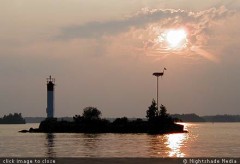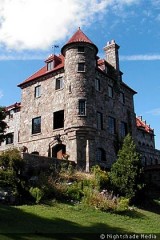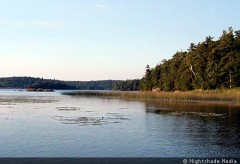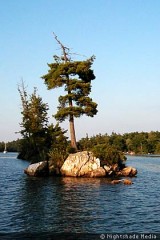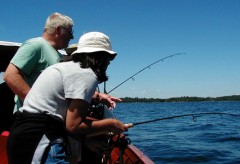1000 Islands … actually many more
Along the border between the New York and Ontario a tremendous volume of fresh water collected in the heartlands of the continent leaves the Great Lakes bound for the Atlantic. That huge flow of water forms one of the great rivers of the world, the St. Lawrence. We all know of the Nile, the Amazon, and the Mississippi rivers yet many people, even some who grew up in central New York, do not contemplate the St. Lawrence with the same awe or appreciation. But still, none of the other major rivers of the world can boast the amazing stretch of granite islands covered with white pine, oak and hemlock that are popularly called The 1000 Islands. Actually there are almost 2,000 islands counting anything that can support the growth of a small tree.
Following the European explorers this region gained popularity in the early 1800’s among naturalists and serious sport fishermen. Then for a period of time around the turn of the century the 1000 Islands were formally “discovered” and built upon in style by wealthy industrialists and entrepreneurs. Large hotels and smaller inns were built to attract those who could not afford to build a grand cottage and a wealth of history was left in the process. As Kentucky is known for a love of horses, the 1000 Islands region has a love of boats. Some great wooden boats were built along the St. Lawrence and the Antique Boat Museum in Clayton, NY is the place to start if old boats are of interest.
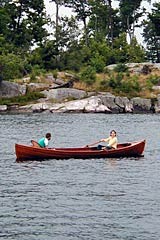
St. Lawrence Skiff Rowing
Then there is the river itself where a boat is definitely required for proper exploration. You can rent a small motorboat many places along the river for a daytime excursion. Just make sure you have a proper river chart and know how to identify the shoals. There are many and they are mostly all granite! I would not recommend canoeing the river except in limited areas of calm water. There are some stretches that can become quite choppy for a canoe. The traditional human-powered craft of the region was called the St. Lawrence Skiff. They are double-ended (typically cedar) lap strake rowing craft that can carry a modest load of camping gear and are very stable. I am not aware of anyplace you can rent a modern version of these craft for an extended outing though there are boat builders in the area still making and restoring them. If you are interested in rowing, Kayaks (and maybe boat camping) would be better than a canoe.
There are quite a few beautiful islands in Canada that are maintained as provincial parks and are open for camping. Be sure to check with both Canadian and US customs before planning an excursion on the river because they have become much more strict about such matters in the wake of 9/11. In all cases be sure to have multiple forms of ID whether driving or boating back and forth to Canada. Most problems or delays are likely to occur at the US side of the border crossing at the Thousand Islands Bridge.
In general the Canadian side of the river is quieter with more islands and tighter passages. The American side is where the shipping channel permits freighters to enter the Great Lakes from the Atlantic and is also where most of the grand houses were built at the turn of the century. The largest town or city in the region is Kingston, Ontario. It is an attractive little city with a busy downtown district and some good pubs near the river. For the Canadians in Ontario, this region is their southern-most point and they value the summer weather. As soon as it gets above 50° the outdoor seating opens up at every cafe in Kingston.
A Very Short History of the 1000 Islands
The Thousand Islands region of the St. Lawrence River is generally considered to consist of about the first 30 miles of this great river. The region is right at the headwaters as it begins its long journey from Lake Ontario to the Atlantic Ocean at the Gulf of St. Lawrence in Canada. Thanks to the terrain building glaciers of the last ice age and thousands of years of water movement from the Great lakes to the ocean, the bedrock granite that divides northern New York state from Canada has been carved to yield an amazing cluster of islands.
In fact, over 1,800 islands actually exist along with over 3,000 shoals. This assessment considers an island to be any landmass that is above the water for 356 days a year and supports the growth of at least one tree. The great majority of shoals in this stretch of the river are composed of granite and as most boaters are keenly aware, can be very hazardous or at least costly.
The Native American tribes knew this region well and considered it to be most special for its enduring natural beauty and abundance of fish and other wildlife. The first white explorers were no less impressed and trappers soon followed the explorers who were in turn followed by settlers. The region saw its share of turmoil as both Canada and the United States emerged from their colonial origins as independent democracies though the natural boundary of the great St. Lawrence River remained difficult to contest as the international border between the two countries.
The first steamboat wharf in Alexandria Bay was constructed in 1823 and by 1830 the small town consisted of about 12 wood framed homes. The region lay somewhat undiscovered until the mid 1800’s when the first islands went up for sale from Azariah Walton who originally owned all of the timber rights in the region. The first island to be sold was Meadow Island in 1854 (now known as Manhattan Island) for $40 to Mr. Seth Green, a well-known naturalist with a particular interest in studying fish and their habitat. This was followed in the following two years by the sale six more islands which included Deer Island to Mr. Samuel Miller in 1856.
An era of great prosperity followed through to the turn of the century and the Thousand Islands region grew to be very popular among the wealthy from New York City and Philadelphia. The stretch of islands along the American channel of the river between Clayton and Alexandria Bay became known as “Millionaire’s Row.” George Pullman, of the Pullman Railroad Car fame, built a small granite castle called Castle Rest and at one time entertained generals Sherman and Grant for a fishing expedition. George Bolt, hotel manager for John Astor, tore down a large wooden cottage to start construction of the now well know tourist attraction, Boldt’s Castle.
With the death of George Boldt’s wife in the early 1900’s it may be thought that a slow but steady demise of the region had begun. Boldt, in mourning, ceased work on the castle and it was never to be completed. The first world war was followed by financial declines and the great stock market crash leading up to the great depression. The millionaires, their cottages and the slow but elegant steamboats gave way first to bootleg liquor and then the faster pace of a restless country and the automobile.
Many grand cottages and hotels of the region burned accidentally. Subsequent owners intentionally tore down others, such as Pullman’s Castle Rest. They could no longer justify the grand size of the houses or pay the large property tax bills. Some of these wonderful structures remain intact, somehow defying the tremendous change in the past 100 years. Those that now lie in ruin still have fascinating stories to tell.
Today, the Thousand Islands region has seen rediscovery. Pleasure boaters and water enthusiasts of all types appear in number as the sun rises on a typical summer’s day. Even new homes are being built in a manner emulating the styles designed for the grand cottages over a hundred years ago.

